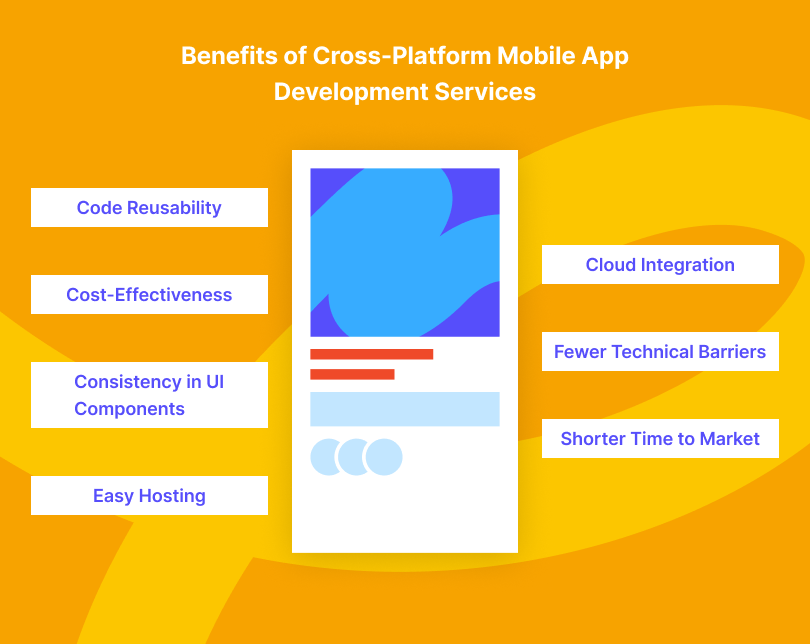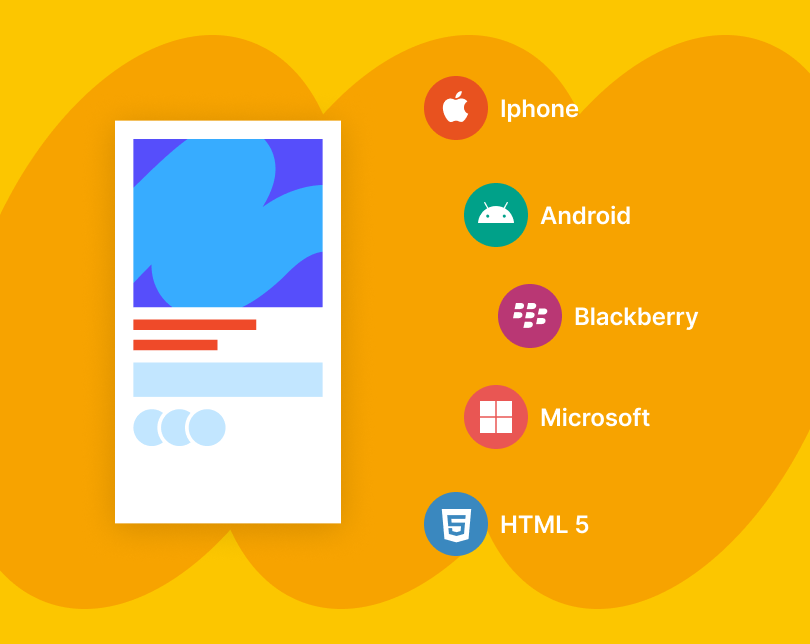Users don't think about operating systems because their only expectation is for apps to work. However, that presents developers with a demanding challenge: build an app once, yet make it run everywhere.
Cross-platform app development is the best solution available, but it’s not as simple as writing code and pressing “deploy.” Performance trade-offs, design limitations, framework choices, and the constant evolution of mobile technology all influence the final product.
This is why a misstep can leave your users frustrated, but execute your approach well, and you’ll save time and expand your reach. This guide breaks down how cross-platform mobile app development works, when it makes sense to use it, and what you should know before you commit.
What is Cross-Platform App Development?
As the name already suggests, a cross-platform app isn’t tied to a single operating system because it adapts instead. Developers write one codebase, but the app runs on iOS, Android, and sometimes even desktops and web browsers.
Flutter has become the tool of choice for many, with 46 percent of devs using it in 2023, which reflected a broader shift away from platform-specific development. The best news is that the industry isn’t just growing. Instead, it’s accelerating.
In 2022, cross-platform framework sales hit $101.7 billion, and projections put annual growth at 16.8% for the next eight years.
Most businesses eyeing this approach see cost savings and faster development. However, how you execute cross-platform app development can make or break the outcome.
The Difference Between Native and Cross-Platform App Development
Every app has one thing in common: it starts with a decision whether to build specifically for one operating system or create something that works on all devices. You’ll find that this choice shapes everything from performance to development speed, meaning it influences how your users will experience the final product.
Performance and Optimization
Being built specifically for iOS or Android, native apps have a specific structure, giving them direct access to the device’s hardware. This means great animations and swifter load times, as well as better access to advanced features like haptic feedback or high-end graphics rendering. Devs make sure to write separate code for each platform and optimize every detail to fit the system’s strengths.
Cross-platform development, on the flip side, relies on frameworks that act as a bridge between a single codebase and multiple operating systems. While modern tools like Flutter and React Native narrow the performance gap, they still introduce layers of abstraction that can impact speed and responsiveness. For this exact reason, you need an experienced team that provides tailored web application development services.
Development Speed and Cost
Whenever you build native apps, you need separate development teams for iOS and Android, which doubles costs and timelines. But that’s rarely what businesses want, as time is precious.
Cross-platform solutions offer a safer path to launch in record time because you only have to write the code once, yet you can release it across multiple platforms. It’s no surprise that this efficiency is why many companies, especially startups, favor cross-platform development when balancing budgets and deadlines.
If you’re exploring cross-platform options, you should also choose the right framework, as this is just as paramount as finding the best web application development platforms for your backend. The optimal combination not only keeps your apps efficient and scalable but also future-proof.
Top 5 Benefits of Cross-Platform Mobile App Development Services

Android or iOS isn’t the only decision to consider when building a mobile app. You must also decide how to reach users wherever they are without doubling development time and costs.
Cross-platform app development services continue to push forward as the pragmatic answer, letting you create striking digital experiences without the inefficiencies of platform-specific coding. But beyond cost savings, why does this approach matter?
1. Faster Time to Market
Traditional development splits resources between multiple teams, each writing native code for a single operating system. That divide is non-existent with cross-platform services.
Devs write once and deploy on all devices, cutting down on delays and getting the app out the door faster. Thanks to this, you can move without stumbling when priorities shift and keep iteration cycles lean.
- A unified codebase means fewer bottlenecks.
- Testing takes less time since the app behaves consistently across platforms.
- Updates roll out simultaneously, reducing version discrepancies.
2. Cost-Effective Development Without Sacrificing Quality
Building two native apps means paying for two teams, two codebases, and two sets of ongoing updates. Cross-platform services cut those expenses, yet performance stays intact.
The best web application development platforms merge effortlessly with mobile frameworks and allow companies to build robust, feature-rich apps without the overhead.
- A single team handles the entire project, reducing coordination issues.
- Shared code minimizes redundancy and makes development more efficient.
- Maintenance costs drop as updates apply universally.
3. Wider Audience Reach
Experience has proven to business owners, time and time again, that the secret to success often lies in having their apps meet users where they are. Cross-platform development ensures that no segment gets left behind, whether they prefer Apple, Android, or even Windows.
Instead of focusing on one group of users, you can grow your audience from day one.
- A consistent experience across all devices boosts engagement.
- No need to choose between iOS-first or Android-first strategies.
- Markets with diverse device preferences are still open to you, so you can easily reach a broader group of users.
4. Easier Maintenance and Scalability
Launching an app is only step one. Updates, bug fixes, performance optimizations, user feedback integration, and new features define long-term success.
Cross-platform development is the most efficient route to easy maintenance since devs only manage one codebase. Scalability becomes more predictable and allows your apps to expand without multiplying complexity.
- Fixes apply universally, so you can skip fragmented updates.
- New features roll out faster with a single development cycle.
- Scaling to new platforms remains straightforward.
5. Consistent UI/UX Across Devices
No matter what device they have in their hands, your users will surely expect fluid and intuitive experiences. Cross-platform app development is unparalleled when it comes to a cohesive design framework.
You can have consistency without forcing designers to reinvent the wheel for each platform.
- A shared UI library maintains brand identity.
- Fewer discrepancies between iOS and Android interfaces.
- Developers can focus on perfecting UX instead of adapting layouts.
How to Develop a Cross-Platform App
Here are the steps your team should take when starting cross-platform app development.
Understand the Expectations for Each Platform
One of the main goals of your cross-platform app is that it should feel natural on every device it runs on. Although it would probably be nice to write a single codebase and call it a day, that’s not how it works in reality.
Your team should really understand how users interact with each platform, and that should guide their plans and strategies.
iOS is synonymous with fluid gestures and a consistent back swipe to navigate between screens. It shouldn’t surprise you that users won’t deviate from having these expectations.
However, you can’t follow the same strategic path with Android users, as they rely on the system’s back button and favor bottom navigation bars over tab bars. You can’t overlook these differences, or the app might feel slightly off.
Even if it technically works, users will notice when an app doesn’t behave the way they expect. However, it’s easy to avoid this trap if you engage with both ecosystems.
Study Apple’s Human Interface Guidelines and Google’s Material Design principles, and test on real devices instead of just emulators. Keep in mind that you should also observe how native apps handle navigation, loading states, and input fields.
Choose a Framework that Matches Your App’s Goals
The last thing you need is to have to rewrite the app a year after launch. The framework you choose determines whether the app can adapt to new devices and handle inevitable updates, so it’s about more than just getting an MVP out the door.
React Native: Fast Iteration but with Trade-offs
Meta’s React Native is the most obvious option if speed is your priority. Your team can use JavaScript, a language most developers are already familiar with.
Moreover, debugging and UI adjustments are nearly instant with the hot reload feature, meaning you can skip worrying about slow development. Eventually, performance bottlenecks can appear as your app grows, especially with complex animations or frequent UI updates.
React Native uses a JavaScript bridge to communicate with native modules, and while devs have found ways to speed things up, heavy rendering tasks and complex gestures can still feel a bit clunky compared to a fully native app.
Flutter: Precision and Performance with a Learning Curve
Google built Flutter to dodge the JavaScript bridge entirely. It compiles directly to machine code, often making it faster than React Native.
Flutter’s built-in widget system allows your team to create highly customized UI elements without depending on native components. This keeps the look consistent across platforms, but that consistency has a downside.
An iOS app built with Flutter won’t always feel fully “iOS-like” since it doesn’t use native UIKit components. Devs also need to learn Dart, a modern language that still lacks JavaScript’s widespread adoption.
Xamarin: Enterprise Integration at a Cost
Developers can use Xamarin to write apps in C# and share code on different platforms while maintaining access to native APIs. The number one reason many businesses choose it for enterprise applications is that they need easy integration with Microsoft’s ecosystem.
But outside that world, however, support thins out. You’ll quickly find that fewer third-party libraries lead to fewer pre-built solutions, and for devs unfamiliar with .NET, the learning curve can be steep.
If your team is working with a broader tech stack, especially if they need a custom web development process, Xamarin will likely feel limited compared to more widely adopted frameworks.

Should You Choose Cross-Platform App Development?
Just a decade ago, devs had little choice. An iPhone app required one team, an Android app another, and both demanded time, money, great effort, and patience.
Cross-platform development changed that and promised a single codebase that runs everywhere. But does that promise hold up to this day, and is that enough for you to choose this approach?
Whether you should opt for cross-platform mobile app development depends on what matters most to your business, which is typically speed, budget, or performance. Cross-platform tools will slash development time and costs for startups racing to market.
For instance, a React Native app can reuse most of its code and accelerate development, but if you’re looking for something more demanding, like 3D graphics or real-time interactions, native code still performs better.
Then there’s also the question of long-term scalability.
- Will your app need frequent OS-specific updates?
- Will platform guidelines shift?
Native apps blend directly with system updates, while cross-platform solutions often wait for framework updates to catch up. You may see this delay as negligible, but it could also be a dealbreaker.
If cross-platform development fits your goals, the next step is choosing a framework. Many devs explore how to create a React Native app, given its neat balance between efficiency and near-native performance. Others turn to Flutter for UI flexibility or Xamarin for Microsoft ecosystem integration. The point is that there’s no universally right choice because convenience comes hand-in-hand with trade-offs in app development.
Conclusion
The gap between native apps and cross-platform app development is continuously shrinking, as major frameworks receive updates every few months. This means that the capabilities are constantly expanding, and performance issues are steadily diminishing.
Don’t hesitate if you want to reach a diverse and broad audience without developing separate native apps. All you need to do is choose the framework that complements your objectives and lays the foundation for the best UX.





